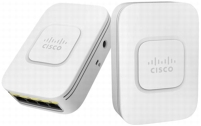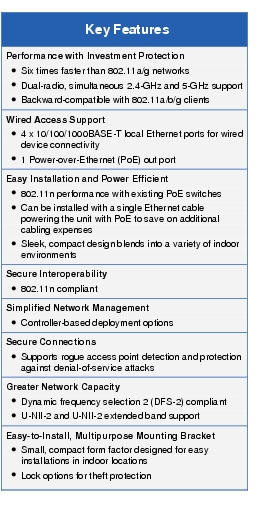|
|


The Cisco® Aironet® 702W Series is a compact, wall-mountable access point for hospitality- and education-focused customers looking to modernize their networks to handle today's increasingly complex wireless access demands.
RF Excellence
• Simultaneous dual band and dual radio with support for 2.4 GHz and 5 GHz in a compact form factor
• Optimized antenna and radio designs: Consistent network transmit and receive for optimized rate versus range
• Radio resource management (RRM): Automated self-healing optimizes the unpredictability of RF to reduce dead spots and help ensure high-availability client connections
• Cisco BandSelect improves 5-GHz client connections in mixed-client environments
• Advanced security features include rogue detection, wireless intrusion prevention system (wIPS), and ContextAware
Product Specifications
Table 1. Product Specifications for Cisco Aironet 702W Series Access Points
|
Item |
Specification |
||||
|
Part numbers |
Cisco Aironet 702W Series Access Point: Indoor environments, with internal antennas • AIR-CAP702W-E-K9: Dual-band, wall plate, controller-based, 802.11a/g/n
• AIR-CAP702W-EK910: Eco-pack (dual-band, wall plate, controller-based, 802.11a/g/n) 10 quantity access points
|
||||
|
Capabilities |
• Management via Telnet and Secure Shell Protocol (SSH)
• Plug-and-play operation with Cisco wireless LAN controllers (both physical and virtual)
• Supported in Cisco Prime™ Infrastructure
• Supports up to 100 associated clients per radio
• Up to 16 Service Set Identifications (SSIDs) per radio
• IPv4 and IPv6 support for clients
• 802.11h
• 802.11e/Wi-Fi Multimedia (WMM)
|
||||
|
Authentication and security |
• Temporal Key Integrity Protocol (TKIP) for Wi-Fi Protected Access (WPA), Advanced Encryption Standard (AES) for WPA2
• 802.1X, Radius, AAA (authentication, authorization, accounting)
• 802.11i
|
||||
|
Deployment modes |
• Controller-based, Cisco FlexConnect™, Monitor mode, Autonomous
|
||||
|
802.11n |
• 2 x 2 multiple-input multiple-output (MIMO) with two spatial streams
• Maximal ratio combining (MRC)
• 20- and 40-MHz channels
• PHY data rates up to 300 Mbps
• Packet aggregation: A-MPDU (Tx/Rx), A-MSDU (/Rx)
• 802.11 dynamic frequency selection (DFS)
• Cyclic shift diversity (CSD) support
• Antenna Diversity
|
||||
|
Data rates supported |
802.11a: 6, 9, 12, 18, 24, 36, 48, 54 Mbps |
||||
|
802.11bg: 1, 2, 5.5, 6, 9, 11, 12, 18, 24, 36, 48, 54 Mbps |
|||||
|
802.11n data rates (2.4 GHz1 and 5 GHz): |
|||||
|
MCS Index2 |
GI3 = 800 ns |
GI = 400 ns |
|||
|
20-MHz Rate (Mbps) |
40-MHz Rate (Mbps) |
20-MHz Rate (Mbps) |
40-MHz Rate (Mbps) |
||
|
0 |
6.5 |
13.5 |
7.2 |
15 |
|
|
1 |
13 |
27 |
14.4 |
30 |
|
|
2 |
19.5 |
40.5 |
21.7 |
45 |
|
|
3 |
26 |
54 |
28.9 |
60 |
|
|
4 |
39 |
81 |
43.3 |
90 |
|
|
5 |
52 |
108 |
57.8 |
120 |
|
|
6 |
58.5 |
121.5 |
65 |
135 |
|
|
7 |
65 |
135 |
72.2 |
150 |
|
|
8 |
13 |
27 |
14.4 |
30 |
|
|
9 |
26 |
54 |
28.9 |
60 |
|
|
10 |
39 |
81 |
43.3 |
90 |
|
|
11 |
52 |
108 |
57.8 |
120 |
|
|
12 |
78 |
162 |
86.7 |
180 |
|
|
13 |
104 |
216 |
115.6 |
240 |
|
|
14 |
117 |
243 |
130 |
270 |
|
|
15 |
130 |
270 |
144.4 |
300 |
|
|
Frequency band and 20-MHz operating channels |
E Regulatory Domain: • 2.412 to 2.472 GHz; 13 channels
• 5.180 to 5.320 GHz; 8 channels
• 5.500 to 5.700 GHz; 8 channels
(excludes 5.600 to 5.640 GHz) |
||||
|
Maximum number of nonoverlapping channels |
2.4 GHz • 802.11b/g:
• 20 MHz: 3
• 802.11n:
• 20 MHz: 3
|
5 GHz • 802.11a:
• 20 MHz: 21
• 802.11n:
• 20 MHz: 21
• 40 MHz: 9 (7 for ETSI)
|
|||
|
Note: This varies by regulatory domain. Refer to the product documentation for specific details for each regulatory domain. |
|||||
|
Maximum transmit power |
2.4 GHz • 802.11b
• 17 dBm with one antenna
• 802.11g
• 20 dBm with two antennas
• 802.11n (HT20)
• 20 dBm with two antennas
|
5 GHz • 802.11a
• 17 dBm with one antenna
• 802.11n non-HT duplicate mode
• 20 dBm with two antennas
• 802.11n (HT20)
• 20 dBm with two antennas
• 802.11n (HT40)
• 20 dBm with two antennas
|
|||
|
Note: The maximum power setting will vary by channel and according to individual country regulations. Refer to the product documentation for specific details. |
|||||
|
Available transmit power settings |
2.4 GHz 20 dBm (100 mW) 17 dBm (50 mW) 14 dBm (25 mW) 11 dBm (12.5 mW) 8 dBm (6.25 mW) 5 dBm (3.13 mW) 2 dBm (1.56 mW) |
5 GHz 20 dBm (100 mW) 17 dBm (50 mW) 14 dBm (25 mW) 11 dBm (12.5 mW) 8 dBm (6.25 mW) 5 dBm (3.13 mW) 2 dBm (1.56 mW) |
|||
|
Note: The maximum power setting will vary by channel and according to individual country regulations. Refer to the product documentation for specific details. |
|||||
|
Integrated antennas |
• 2.4 GHz, gain 3.0 dBi
• 5 GHz, gain 4.0 dBi
|
||||
|
Interfaces |
• 10/100/1000BASE-T autosensing (RJ-45)
• 4x 10/100/1000BASE-T ports (RJ-45) (local Ethernet ports)
• 1 PoE out port (when powered by 802.3at Ethernet switch, or Cisco power injector AIR-PWRJ5=, or Cisco Local Power Supply)
• Management console port (RJ-45)
• DC power connector
|
||||
|
Indicator |
• Status LED indicates boot loader status, association status, operating status, boot loader warnings, boot loader errors
|
||||
|
Dimensions |
• Access point (without mounting bracket): 6 x 4 x 1.6 in. (152.4 x 101.6 x 40.6 mm)
|
||||
|
Environmental |
Cisco Aironet 702W • Nonoperating (storage) temperature: -22° to 158°F (-30° to +70°C)
• Nonoperating (storage) altitude test: 25°C, 15,000 ft.
• Operating temperature: 32° to 104°F (0° to 40°C)
• Operating humidity: 10% to 90% percent (noncondensing)
• Operating altitude test: 40°C, 9843 ft.
|
||||
|
System |
• 128 MB DRAM
• 128 MB flash
• 560 MHz system CPU
|
||||
|
Input power requirements |
• 44 to 57V DC
• Optional: Power supply and power injector: 100 to 240V AC; 49 to 60 Hz
|
||||
|
Powering options |
• 802.3af/at Ethernet switch
• Optional: Cisco Power Injectors (AIR-PWRINJ5=, AIR-PWRINJ4=)
• Optional: Cisco Local Power Supply
|
||||
|
Power draw |
• 9.5 to 10.25W (typical range without PoE out)
Note: When deployed using PoE, the power drawn from the power sourcing equipment will be higher by some amount, depending on the length of the interconnecting cable. |
||||
|
Warranty |
Limited Lifetime Hardware Warranty |
||||
|
22 MCS Index: The Modulation and Coding Scheme (MCS) index determines the number of spatial streams, the modulation, the coding rate, and data rate values.
|
Limited Lifetime Hardware Warranty
Cisco Wireless LAN Services